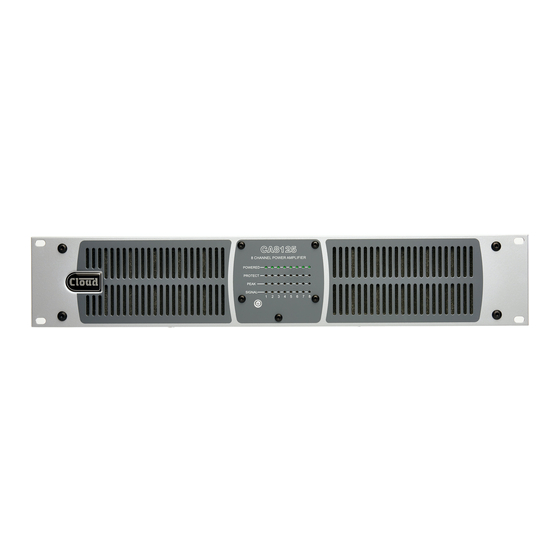- ページ 2
コントロールユニット Cloud CA2500のPDF テクニカル・ニュースをオンラインで閲覧またはダウンロードできます。Cloud CA2500 13 ページ。
Cloud CA2500 にも: インストールとユーザーマニュアル (19 ページ)

•
Fault conditions which affect an entire channel group (odd or even), or all channels in the case of a
CA2250, due to intervention from the PSU, or because the fault condition is originating in the PSU
itself.
It is possible for a PSU to be thermally overloaded, for example, in a power-sharing scenario, where
multiple channels on the same PSU are delivering a total speaker load of more than 500W, and this
would lead to the temporary shutdown of the PSU.
Shutting down the PSU will lead to the shutdown of all of the amplifier modules on that PSU, due to
the loss of the high voltage rails. Multiple channel protect LEDs would illuminate to indicate this.
However, this type of shutdown would be temporary, and the PSU would quickly recover and re-
instate all of its amplifier channels to normal operation. No further action should be necessary, beyond
the review of the total speaker wattage loading for that PSU, for example.
A DC protect condition on one or more amplifier channels, will always require the intervention of the
PSU for those channels, because it requires the high-voltage DC supply rails to be turned off, to
prevent possible damage to the connected speakers. If the high-voltage supply rails are turned off,
then all amplifier modules connected to that PSU, will also go into protect, and will therefore
illuminate their "protect" LEDs. DC protect conditions will never self-recover, and external AC mains
power must be removed, via disconnection of the mains cable, or other external power switching
mechanism. The front-panel "soft" power switch will not clear this type of condition. A DC protect
condition in a particular amplifier module, will generally require the replacement of that module, as it
usually indicates failure of the output stage. As all protect LEDs will be illuminated, it may not be
obvious which module has failed. This will require a process of elimination to identify the failed
module.
The remainder of this technical bulletin, describes the equipment and procedures necessary to safely identify
and replace, faulty PSUs and amplifier modules.
Equipment required
•
PH0 screwdriver (CV Series chassis screws only)
•
PZ1 screwdriver (CA Series chassis screws and amplifier / PSU module M3 machine screws)
•
Digital multi-meter, set to DC volts, with a selected range suitable for reading up-to 100v DC.
•
1Kohm, 2W power resistor, with exposed connections sheathed, and connected to a pair of insulated-
body probes (e.g. multi-meter type probes) which can be used to selectively discharge power supply
rails. E.g.
